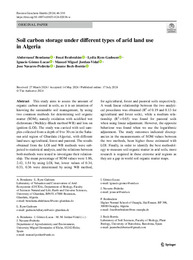Por favor, use este identificador para citar o enlazar este ítem:
https://hdl.handle.net/11000/34627Registro completo de metadatos
| Campo DC | Valor | Lengua/Idioma |
|---|---|---|
| dc.contributor.author | Benslama, Abderraouf | - |
| dc.contributor.author | Fouzi, BENBRAHIM | - |
| dc.contributor.author | Lydia Rym, Gadoum | - |
| dc.contributor.author | Gómez Lucas, Ignacio | - |
| dc.contributor.author | Jordan Vidal, Manuel M. | - |
| dc.contributor.author | Navarro-Pedreño, Jose | - |
| dc.contributor.author | Bech, Jaume | - |
| dc.contributor.other | Departamentos de la UMH::Agroquímica y Medio Ambiente | es_ES |
| dc.date.accessioned | 2025-01-16T18:12:11Z | - |
| dc.date.available | 2025-01-16T18:12:11Z | - |
| dc.date.created | 2024-07 | - |
| dc.identifier.citation | Environ Geochem Health (2024) 46 | es_ES |
| dc.identifier.issn | 1573-2983 | - |
| dc.identifier.issn | 0269-4042 | - |
| dc.identifier.uri | https://hdl.handle.net/11000/34627 | - |
| dc.description.abstract | This study aims to assess the amount of organic carbon stored in soils, as it is an intention of knowing the sustainable soil management, by using two common methods for determining soil organic matter (SOM), namely oxidation with acidified wet dichromate (Walkley–Black method-WB) and loss on ignition (LOI). The study was carried with soil samples collected from a depth of 0 to 30 cm in the Saharan arid region of Ghardaïa (Algeria), with different land uses: agricultural, forest and pastoral. The results obtained from the LOI and WB methods were subjected to statistical analysis, and the relations between both methods were tested to investigate their relationship. The mean percentage of SOM values were 1.86, 2.42, 1.54 by using LOI, but, lower values of 0.34, 0.33, 0.36 were determined by using WB method, for agricultural, forest and pastoral soils respectively. A weak linear relationship between the two analytical procedures was obtained ( R2 of 0.19 and 0.13 for agricultural and forest soils), while a medium relationship ( R2 = 0.65) was found for pastoral soils when using linear adjustment. However, the opposite behaviour was found when we use the logarithmic adjustment. The study outcomes indicated discrepancies in the measurements of SOM values between the two methods, been higher those estimated with LOI. Finally, in order to identify the best methodology to measure soil organic matter in arid soils, more research is required in these extreme arid regions as they are a gap in world soil organic matter maps. | es_ES |
| dc.format | application/pdf | es_ES |
| dc.format.extent | 14 | es_ES |
| dc.language.iso | eng | es_ES |
| dc.publisher | Springer | es_ES |
| dc.rights | info:eu-repo/semantics/openAccess | es_ES |
| dc.rights | Attribution-NonCommercial-NoDerivatives 4.0 Internacional | * |
| dc.rights.uri | http://creativecommons.org/licenses/by-nc-nd/4.0/ | * |
| dc.subject | Arid conditions | es_ES |
| dc.subject | Forestry | es_ES |
| dc.subject | Loss on ignition method | es_ES |
| dc.subject | Pastoral | es_ES |
| dc.subject | Soil organic matter | es_ES |
| dc.subject | Walkley | es_ES |
| dc.subject | Black method | es_ES |
| dc.subject.other | CDU::6 - Ciencias aplicadas::62 - Ingeniería. Tecnología | es_ES |
| dc.title | Soil carbon storage under different types of arid land use in Algeria | es_ES |
| dc.type | info:eu-repo/semantics/article | es_ES |
| dc.relation.publisherversion | https://doi.org/10.1007/s10653-024-02036-w | es_ES |

Ver/Abrir:
s10653-024-02036-w.pdf
1,3 MB
Adobe PDF
Compartir:
 La licencia se describe como: Atribución-NonComercial-NoDerivada 4.0 Internacional.
La licencia se describe como: Atribución-NonComercial-NoDerivada 4.0 Internacional.
.png)